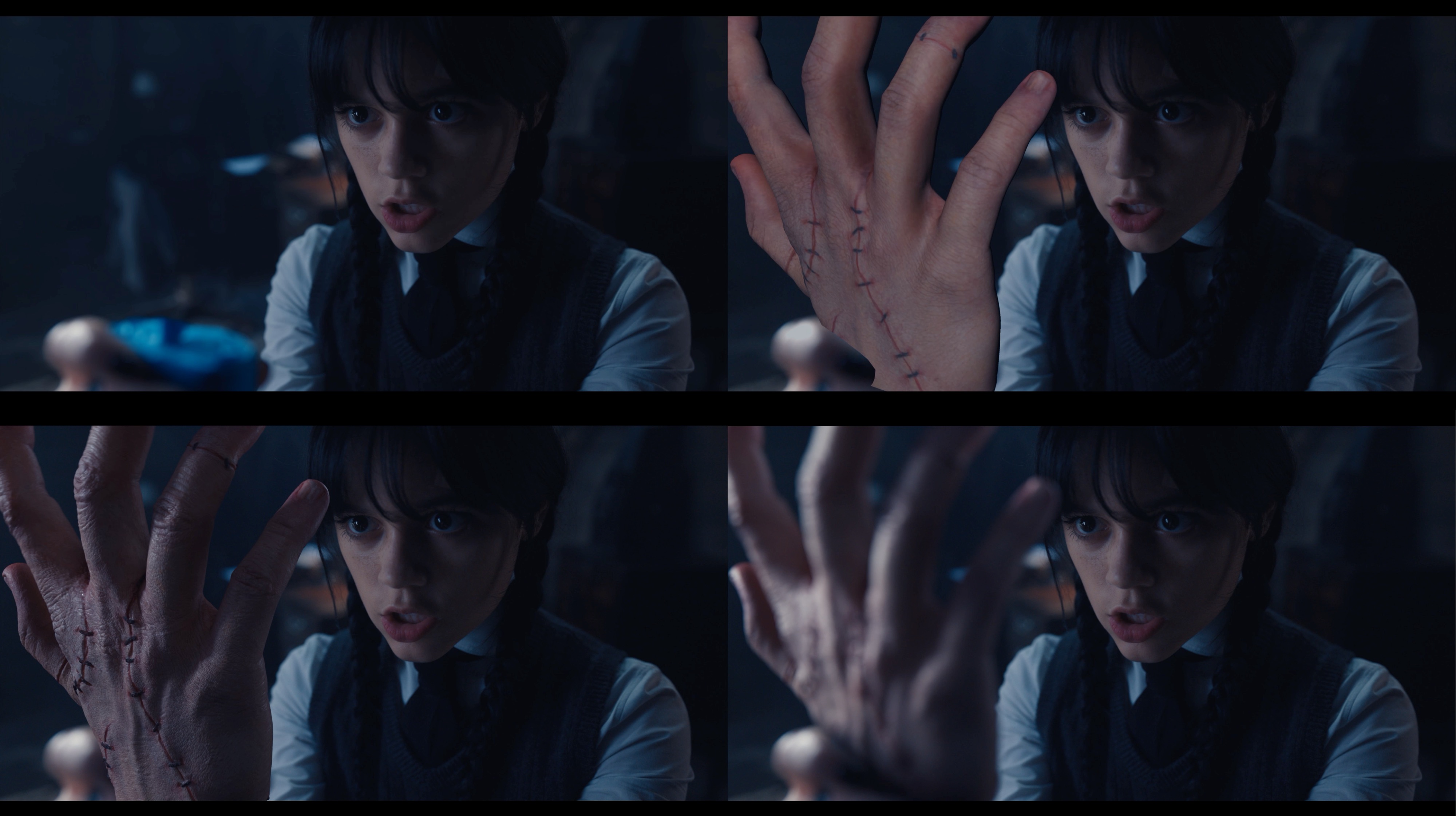Behind the scenes of the visual effects for Thing in the hit Tim Burton show.
One of the stand-out characters in Netflix’s Wednesday series is, of course, the sentient disembodied hand called Thing.
Largely brought to life by performer Victor Dorobantu on set with make-up and prosthetic effects, Thing was also realized as a completely CG ‘creature’ for certain sequences.
This CG Thing was handled by visual effects studio MARZ (Monsters Aliens Robots Zombies), which was awarded the work after delivering several test shots of a digital Thing that captured the tone of the character, including how it emotes, and the way it walks, carries objects, and leaps from a static position.
Here, befores & afters speaks to MARZ visual effects producer Casey Sincic, lighting supervisor James Higuchi, and compositing lead Rodrigo Paiva about what it took to match Dorobantu’s exquisite on-set performance with their synthetic hand.
b&a: Casey, maybe you could talk about the brief for Thing in terms of what MARZ was asked to do.
Casey Sincic: The idea was that Tim Burton always wanted to shoot Thing as a real life actor with a real life hand. But there are shots and there are sequences and there are moments where that wasn’t possible. And then there are, of course, sequences where they film it on set and for whatever reason, Victor Dorobantu, the actor who played Thing, his performance doesn’t line up with what they were looking for and so they come to us to recreate that.
The work that we did on Thing is a combination of those two aspects. It was us building these shots from scratch, essentially, and building Thing’s action from scratch and almost directing how Thing would act. There are some shots, too, where we had reference of the live action performance of the hand and our job was to tweak it, make it look more realistic, or recreate it in a slightly different way.
James Higuchi: The initial ask was if we wanted to be involved and everybody here said, ‘We want to do Thing. Let’s try and get the Thing asset and as much of that scope of work as possible!’ So what we ended up doing was a little short film based off of one of several initial test models that we did.
And of course we got the gig!

b&a: What happened when MARZ then came on board the show?
Rodrigo Paiva: Then there was a second test, where they had shot some live action for the actual show with Victor Dorobantu, who performed with his own hand with make-up and prosthetics and wearing a bluescreen outfit. Our job was to mimic what he did and do a side-by-side to match exactly to the ‘real’ Thing.
James Higuchi: We were dialing in the thickness of the geo by half a millimeter by the end of it just to get the volume retention and making sure everything was one-to-one, for that second test. I think the best shows do a mix of practical and VFX. To me, there is nothing that sells an effect more than both actual captured on-set photography mixed with CG.
If you do one or the other, there’s always going to be a shortcoming, but together, they really can produce something that is just completely believable. So they spent a lot of time on set with a practical prosthetic where Victor had this little hump on the back of his hand for the truncated wrist, and the make-up and onset work that they did was fantastic reference.
b&a: For the Thing shots you worked on, what did you receive from production? Obviously, there’s the plate photography, but were there photogrammetry scans, texture scans and other things?
James Higuchi: We received a full data set, as well as photogrammetry and photo lineups.
Rodrigo Paiva: In addition to that, they also provided HDRs for every single shot and gray balls for lighting reference.
Casey Sincic: They gave us a lot of filmed references of Victor moving as Thing as well, so we could reference the different speeds at which the hand would run.
b&a: Human skin is something that can be done in CG, but I’m curious what the challenges here were for Thing, whether you were matching human Victor skin or whether there was something else because of extra makeup applied.
James Higuchi: For the most part, we were matching the practical effect. Honestly, the biggest headache that we ended up running into was inconsistency with practical makeup because, obviously, they are in makeup every day and it’s not going to be exactly the same application. It meant the textures might change from shot to shot, and so that meant we also had to be flexible.
b&a: Can you break down how a couple of your CG Thing shots worked, maybe the underwater shot first?
Rodrigo Paiva: The diving shot itself was a particularly interesting shot. We started with the on-set footage of Victor, then we cleaned that up by taking out his body and leaving just the hand. But because in the second half of the sequence he still has an arm, there was a constraint on the anatomy. So we decided to pivot that shot completely and make it full CG.
James Higuchi: The gravity doesn’t work if you’re supported by an arm. If it’s just this dismembered hand floating around, the way that it interacts in a buoyant environment is going to be completely different.
Then there’s the shot of Thing when he drops out of the car. That was always planned as a CG shot. They filmed Victor on set for practical reference, but that was bid as a CG shot from the beginning.




























